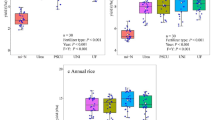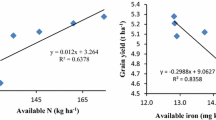Abstract
This study was carried out to verify the applicability of variable rate fertilization (VRF) based on soil testing and diagnosis of rice plant growth for high quality rice production of var. Chucheongbyeo at the farm level. The field trials were conducted at Icheon in Gyeonggi province on a 10 ha farm consisting of 45 experimental fields. For comparative study, 15 field trials were carried out adopting fertilizer management (FPM) practices currently used by farmers. FPM fields were managed by each rice grower using current cultivation methods, but in each VRF field fertilizer application was prescribed using soil test results and the amount of N fertilizer for top-dressing at panicle initiation stage was calculated using rice growth value at that stage. In VRF fields, the total amount of N fertilizer application was less (72 kg ha−1) than that in FPM fields (103 kg ha−1). However, the amount of K2O fertilizer application was more in VRF fields (60 kg ha−1) than that in FPM fields (52 kg ha−1). The amount of P2O5 fertilizer application was similar between the VRF and FPM fields. Plant height was significantly shorter and the number of tillers was significantly more at VRF fields than at the FPM fields. Coefficient of variation (CV) of each growth characteristic measured in VRF was lower than that of FPM fields at panicle initiation stage. There was no difference in culm and panicle length and panicle number between them at the grain filling stage, but CV of panicle numbers per m2 decreased in VRF compared with that of the FPM fields. Rice yield was not different between VRF and FPM fields despite higher brown rice recovery and 1,000-grain weight in VRF fields. Under VRF management, head rice yield increased due to an increase in head rice ratio accompanied by a reduction in brown rice protein content and variation of quality characteristics. These results suggest that VRF application based on soil tests and measurement of rice growth value at panicle initiation stage has the potential for quality control and production of high quality rice through increasing uniformity of growth and reducing the variability in quality among individual fields.
Similar content being viewed by others
References
Angus JF, St. Groth CFD, Tasic RC. 1990. Between-farm variability in yield responses to inputs of fertilizers and herbicide applied to rainfed lowland rice in the Philippines. Agric. Ecosyst. Environ. 30: 219–234
Barker R, Dawe D. 2002. The transformation of the Asian rice economy and the directions for future research; the need for increased productivity. Developments in the Asian rice economy. IRRI. pp 1–30
Bijay-Singh, Yadvinder-Singh, Ladha JK, Bronson KF, Balasubramanian V, Jagdeep-Singh, Khind CS. 2002. Chlorophyll meter- and leaf color chart-based nitrogen management for rice and wheat in northwestern India. Agron. J. 94: 821–829.
Das Gupta DK. 1972. Effects of nitrogen application on nitrogen content of grains of swamp rice in sierra leone. Exp. Agric. 8: 155–160
De Datta SK. 1981. Principles and Practices of Rice Production. John Wiley & Son, Inc.
Dobermann A, Cassman. 2002. Plant nutrient management for enhanced productivity in intensive grain production systems of the United States and Asia. Plant Soil 247: 153–175
Harmandeep SK, Steven BP, Bijay-Singh, Achim D, Ajmer SS, Yadvinder-Singh, Shaobing P. 2007. Performance of site-specific nutrient management for irrigated, transplanted rice in northwest India. Agron. J. 99: 1436–1447
Inada K. 1965. Studies on a method for determining the deep ness of green color and chlorophyll content of intact leaves and its practical application. Proc. Crop Sci. Soc. Jpn. 33: 301–308
Juliano BO. 1972. Physicochemical properties of starch and protein in relation to grain quality and nutritional value in rice. In International Rice Research Institute. Rice Breed. Los Baños, Philippines, pp. 389–405
Juliano BO. 1979. The chemical basis of rice grain quality. In proceeding of Workshop on chemical aspects of rice grain quality. IRRI, Los Baños, Laguna, Philippines, pp: 69–90
KOSIS. 2009. http://www.kosis.kr/nsportal/ups_01List01.jsp?pubcode=IO. Korean Statistical Information Service
Lee JH, Han SW, Park JS, Chi JH, Kim HD, Park KR. 2007. High quality rice production manual of Chucheongbyeo, Gyeonggido Agricultural Research & Extension Services, Hwaseong, Republic of Korea, pp. 3–49
Lee JH, Kang CS, Roh AS, Park KY, Lee HJ. 2009. Assessment of topdressing rate at panicle initiation stage with chlorophyll meter-based diagnosis in rice. J. Crop Sci. Biotech. 12: 191–196
Matsushima S, Matsuzaki A, Tomita T. 1970. Analysis of yield determining process and its application to yield-prediction and culture improvement of lowland rice. Proc. Crop Sci. Soc. Jpn. 39: 231–236
Matsuzaki A, Kariya K, Machida H, Tsunoda K, Nishikawa Y. 1982. Studies on the growth control and the nutritional diagnosis in rice plants. Jpn. J. Crop Sci. 51: 325–331
MIFAFF. 2009. http://www.mifaff.go.kr/USR/WPGE0201/m_119/DTL.jsp. Ministry for food, Agriculture, Forestry and Fisheries
NIAST. 2000. Soil and Plant Analysis Method. National Institute of Agricultural Science and Technology, Rural Development Administration, Suwon. Republic of Korea
NIAST. 2006. Criteria for crop fertilization. revised edition. National Institute of Agricultural Science and Technology. Rural Development Administration, Suwon, Republic of Korea, pp. 21–22
Peng S, Cassman KG. 1998. Upper thresholds of nitrogen uptake rates and associated N fertilizer efficiencies in irrigated rice. Agron. J. 90: 178–185
Perez M, Juliano BO, Liboon SP, Alcantara JM, Cassman KG. 1996. Effects of late nitrogen fertilizer application on head rice yield, protein content, and grain quality of rice. Cereal Chem. 73: 556–560
RDA. 2003. Agricultural Science and Technology Research Guide. Rural Development Administration, Suwon, Republic of Korea, pp. 271–290
Tamaki M, Ebata M, Tashiro T, Ishikawa M. 1989. Physico-eco logical studies on quality formation of rice kernel. Jpn. J. Crop Sci. 58: 653–658
Wang G, Doberman A, Witt C, Sun Q, Fu R. 2001. Performance of site specific nutrient management for irrigated rice in southeast China. Agron. J. 93: 869–878
Wells BR, Faw WF. 1978. Short-statured rice responses to seed ing and N rates. Agron. J. 70: 477–480
Wopereis MCS, Donovan C, Nebie B, Guindo D, N’Diaye MK. 1999. Soil fertility management in irrigated rice systems in the Sahel and Savanna regions of West Africa. Part I-Agronomic analysis. Field Crops Res. 61: 125–145
Zakaria S, Matsuda T, Nitta Y. 2000. Effects of nitrogen application of the development and accumulation of protein bodies in developing rice seed. Plant Prod. Sci. 3: 84–93
Author information
Authors and Affiliations
Corresponding author
Rights and permissions
About this article
Cite this article
Lee, JH., Abawi, Y., Kang, CS. et al. Field-specific variable rate fertilizer application based on rice growth diagnosis and soil testing for high quality rice production. J. Crop Sci. Biotechnol. 14, 79–84 (2011). https://doi.org/10.1007/s12892-010-0073-0
Received:
Revised:
Accepted:
Published:
Issue Date:
DOI: https://doi.org/10.1007/s12892-010-0073-0




